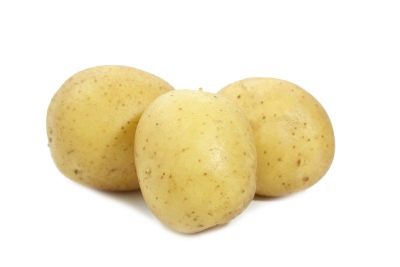
- Authors: Germany
- Year of approval: 1998
- Appointment: dining room
- Tuber size: medium to large
- Tuber weight, g: 58-105
- Peel color: yellow
- Color of the pulp: light yellow
- Starch content,%: 10,6-14,4%
- Tuber shape: oval-rounded
- Peel structure: smooth to medium
At the moment, there are over 4,000 different varieties of potatoes. They differ in yield, ripening and care. Early maturing varieties are in great demand. Karatop potatoes are just such.
Breeding history
The variety was bred by German breeders who worked for Norika Nordring-Kartoffelzucht Und Vermehrungs-GmbH. Development began in 1994, and in 1998 the culture was released.
Popular growing regions in Russia are North-West, Volgo-Vyatka, West Siberian and Middle Volga.
Description of the variety
The culture is low, stem type. The tops are semi-erect, sometimes spreading.
Leaves are medium in size, there are also very small ones. They are intermediate, with slight waviness at the edges.
Inflorescences are small or medium, white in color. On the stems they are formed a little, as well as berries later. They are small, green, rounded in shape.
The root system is well developed. From 16 to 25 tubers are formed.
The advantages include fast ripening times, unpretentious care and excellent taste. As well as keeping quality, possibility of transportation and good tolerance of mechanical cleaning.
Among the disadvantages can be noted the need for additional watering, since the culture does not like drought. Gardeners also produce fruits that are relatively small in weight.
Characteristics of the appearance of the bush and root crops
The fruits are oval-rounded. The mass of one tuber ranges from 58 to 105 g. The maximum weight indicators noted by gardeners were 130 g.
The skin is smooth, with a slight, barely perceptible roughness. Yellow color. Eyes on the peel are formed superficially, shallow in depth.
The pulp is light yellow, firm.
Purpose and taste of tubers
Potatoes Karatop refers to table varieties. Used to prepare various dishes. During heat treatment, the fruits are not boiled, moderately crumbly, not tough. The taste is rich and full-bodied. It is grown commercially for the preparation of convenience foods (such as crisps or instant purees).
The tasting score is 4.8 points. Dry matter in pulp is 18%, starch contains from 10.6 to 14.4%.
Maturation
Early ripe potatoes. The ripening period takes from 60 to 75 days. You can dig up potatoes for testing in 40-50 days.
Yield
The Karatop variety belongs to crops, but the indicators may differ depending on the growing regions. For example, in the North-West region, the average yield is 198-436 c / ha. And in the Middle Volga - only 184-271 centners per hectare. In the Kaliningrad region, the maximum yield indicators are reached - 494 c / ha.
Growing and care
The planting of the culture takes place in mid-May, when the soil temperature will be + 9 ° C. In regions with variable weather conditions, it is best to plant potatoes at the end of May.
Before planting, the selected area is processed and dug up with useful minerals. In no case should fresh manure be added, as it may contain fungal spores.
For two weeks, the material selected for planting is dried and left for germination. Periodically, the potatoes are sprayed with water so that the eyes germinate better.
On the site, holes are formed with a depth of a bayonet shovel. The distance between the pits is 30 cm, and between the rows is 70 cm.Potatoes should not be planted too close to each other, if one bush is infested with pests, all others may suffer.
Further care is as follows.
Watering. Irrigation should be regular and abundant, as the crop does not like drought. With sufficient moisture, more tubers are formed, and their sizes become above average. Active watering continues until flowering, and then stops, since there is a chance to infect the bushes with late blight.
Loosening ensures the removal of a hardened, hard crust on the soil surface, which does not allow oxygen to pass to the tubers. Loosening is different from hilling and is carried out more often. And also it is carried out for additional weed removal.
Hilling is carried out 2 times per season. The first hilling occurs at the moment when the bush stretches up to 25 cm in height, the second is carried out after 2-3 weeks.

Planting potatoes is one of the main spring activities traditional for Russian gardeners. There are many ways to plant this vegetable, allowing you to get a good harvest in different conditions and climates. Before planting, you need to carefully prepare the planting material, correctly determine the timing, competently prepare the soil.


Soil requirements
Potatoes Karatop can grow on any soil. However, heavy soil should be avoided, as it retains moisture excessively. According to the originators, it is best to grow the crop on neutral soil with an average nitrogen content.

Disease and pest resistance
The variety has a fairly high immunity to potato crayfish, mosaic and golden nematode. The most important crop pests are the Colorado potato beetle and late blight.
The Colorado potato beetle can be removed by treating the bushes with Prestige or manually collecting beetles and larvae.
Spraying with fungicides, for example, "Oxygumat", helps against late blight.
And also the potatoes are sprayed just for preventive purposes 2 times per season. The first time - before the formation of flowers, the second time - after the appearance of the berries.

Potatoes are a popular vegetable crop that many gardeners planted on their site. But it is unlikely that it will be possible to grow a bountiful harvest of tasty and large tubers if the beds are not properly protected from the most common diseases and pests. Often, the development of diseases of various etiologies of potatoes goes unnoticed, so it is important to identify the problem in time and eliminate it.
















































































